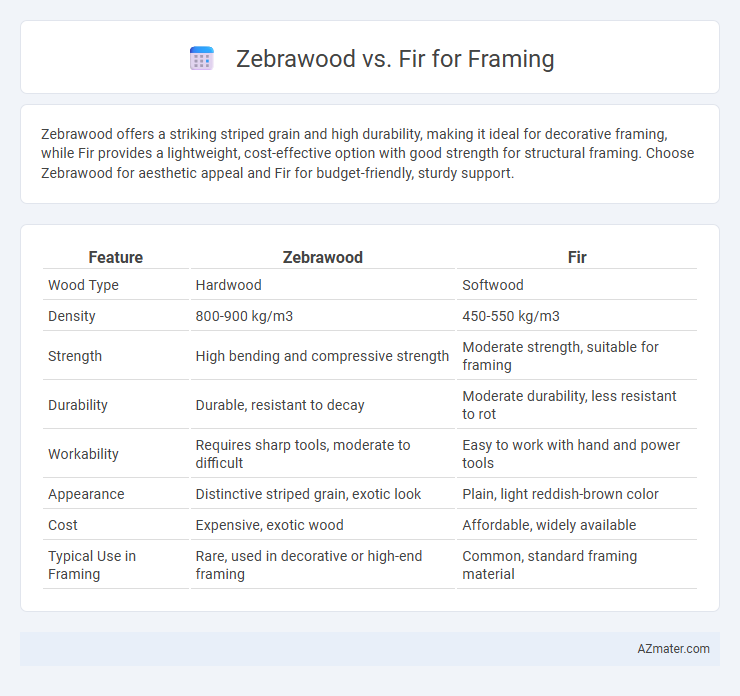Zebrawood offers a striking striped grain and high durability, making it ideal for decorative framing, while Fir provides a lightweight, cost-effective option with good strength for structural framing. Choose Zebrawood for aesthetic appeal and Fir for budget-friendly, sturdy support.
Table of Comparison
| Feature | Zebrawood | Fir |
|---|---|---|
| Wood Type | Hardwood | Softwood |
| Density | 800-900 kg/m3 | 450-550 kg/m3 |
| Strength | High bending and compressive strength | Moderate strength, suitable for framing |
| Durability | Durable, resistant to decay | Moderate durability, less resistant to rot |
| Workability | Requires sharp tools, moderate to difficult | Easy to work with hand and power tools |
| Appearance | Distinctive striped grain, exotic look | Plain, light reddish-brown color |
| Cost | Expensive, exotic wood | Affordable, widely available |
| Typical Use in Framing | Rare, used in decorative or high-end framing | Common, standard framing material |
Introduction to Zebrawood and Fir
Zebrawood, known for its bold grain pattern and high strength, is a premium hardwood often used in decorative framing and high-end woodworking projects. Fir, a softwood with excellent dimensional stability and ease of work, is commonly chosen for structural framing due to its lightweight and cost-effectiveness. While Zebrawood offers superior aesthetics and durability, Fir provides practical benefits for large-scale framing applications where budget and functionality are prioritized.
Botanical Origins and Characteristics
Zebrawood (Microberlinia brazzavillensis) originates from West African rainforests, prized for its distinct dark brown to black striping on a light golden background, offering high durability and distinctive aesthetics for framing. Fir (Abies spp.), typically sourced from North American and European forests, features a pale yellow to reddish-brown hue with a straight grain, valued for its lightweight and ease of handling in structural framing. The density of zebrawood, approximately 830 kg/m3, contrasts with fir's lighter 450-550 kg/m3 range, influencing their selection based on strength and visual impact in framing projects.
Strength and Durability Comparison
Zebrawood offers exceptional strength and durability, making it ideal for heavy-duty framing applications due to its high density and resistance to wear. Fir, while lighter and easier to work with, provides moderate strength and good dimensional stability, suitable for standard framing where load requirements are lower. In terms of longevity, Zebrawood outperforms Fir by resisting decay and insects more effectively, ensuring a longer-lasting structural frame in demanding environments.
Workability and Machining Differences
Zebrawood's dense and oily texture offers moderate workability but requires sharp tools to prevent tear-out during machining, making it less forgiving than fir. Fir boasts superior workability due to its uniform grain and softness, allowing easier cutting, shaping, and fastening with standard woodworking tools. Machining zebrawood demands slower feed rates and careful handling to achieve clean edges, while fir machines smoothly, reducing tool wear and increasing efficiency in framing applications.
Aesthetic Appeal: Grain and Color
Zebrawood offers a striking aesthetic appeal with its bold, contrasting dark and light stripes that create a dramatic and exotic grain pattern, making it ideal for standout framing projects. Fir features a more subdued, consistent grain with a warm reddish-brown hue, providing a classic and natural look that blends seamlessly into traditional or rustic interiors. The choice between Zebrawood and Fir for framing largely depends on whether a vivid, eye-catching design or a warm, understated appearance is desired.
Resistance to Decay and Insects
Zebrawood exhibits superior resistance to decay and insect attacks compared to Fir, due to its dense grain and natural oils that deter pests and moisture. Fir, while commonly used in framing, is more susceptible to fungal decay and insect infestations without proper treatment or sealing. Selecting Zebrawood for framing projects ensures enhanced durability and longevity in environments prone to moisture and pest exposure.
Environmental and Sustainability Factors
Zebrawood, harvested primarily from West Africa, offers a dense, durable option but faces sustainability challenges due to overharvesting and limited reforestation efforts in its native regions. Fir, commonly sourced from fast-growing temperate forests in North America, supports more sustainable forestry practices, including certification programs like FSC, promoting responsible management and reduced environmental impact. When choosing between the two for framing, fir presents a more eco-friendly choice owing to its renewability and lower carbon footprint compared to the exotic and less sustainably sourced zebrawood.
Cost and Availability
Zebrawood is significantly more expensive than fir, primarily due to its exotic status and limited supply, making it less accessible for large-scale framing projects. Fir, widely grown in North America, offers a cost-effective and readily available option for framing, ensuring steady supply and lower prices. The choice between zebrawood and fir depends largely on budget constraints and project scale, with fir dominating in affordability and availability.
Best Uses in Framing Applications
Zebrawood's dense, hard texture and striking grain patterns make it ideal for decorative framing applications requiring durability and a high-end aesthetic. Fir, known for its straight grain and moderate strength, excels in structural framing where cost-effectiveness and workability are priorities. Combining Zebrawood's visual appeal with Fir's functional performance can optimize framing projects, balancing beauty and practicality.
Conclusion: Choosing Between Zebrawood and Fir
Zebrawood offers exceptional durability and unique aesthetics, making it ideal for high-end framing projects where visual impact is crucial. Fir provides cost-effective strength and stability with a lighter weight, suitable for large or structural frame applications. Selecting between Zebrawood and Fir depends on balancing budget constraints, desired appearance, and the specific structural requirements of the framing project.

Infographic: Zebrawood vs Fir for Framing
 azmater.com
azmater.com